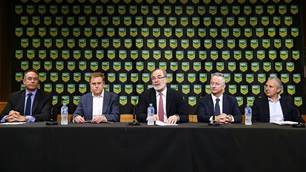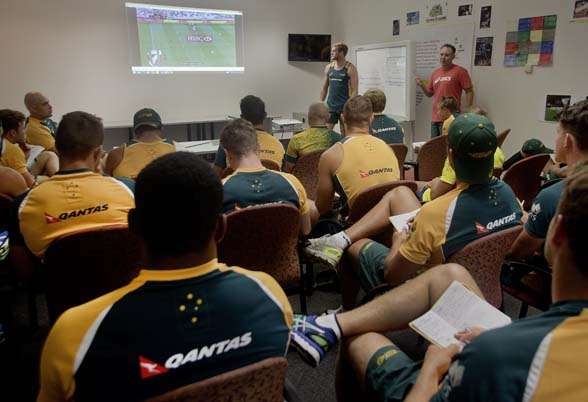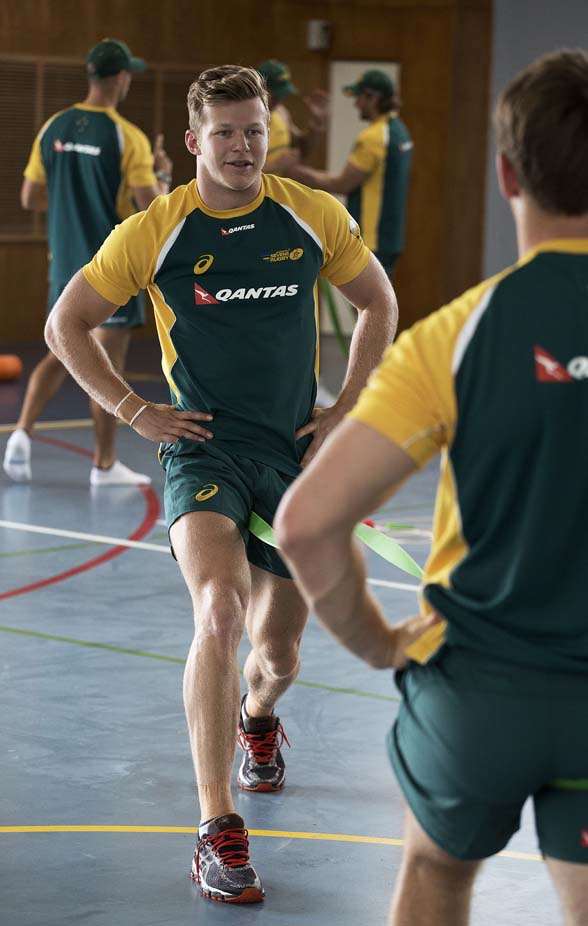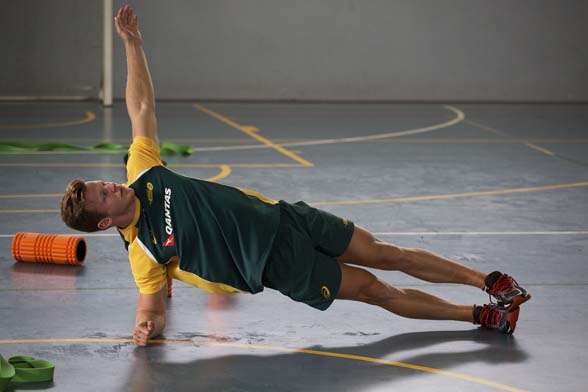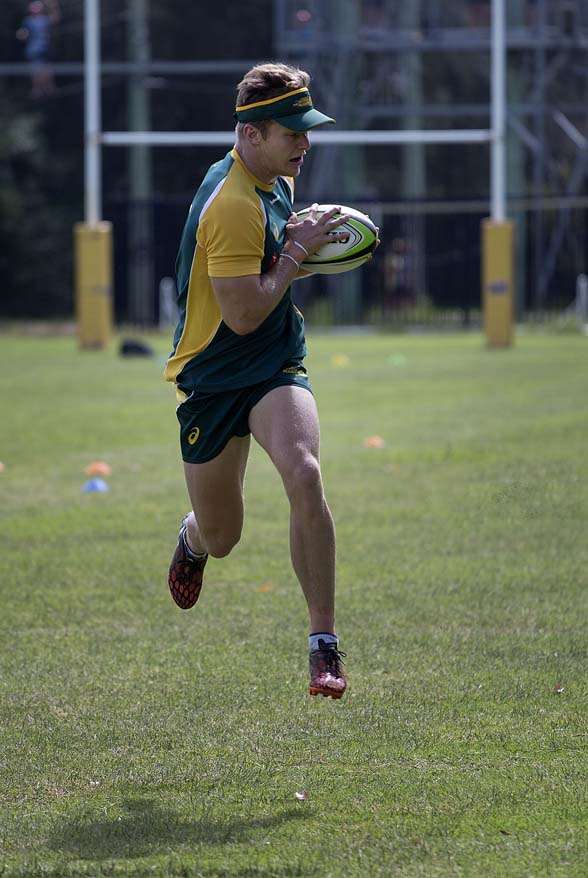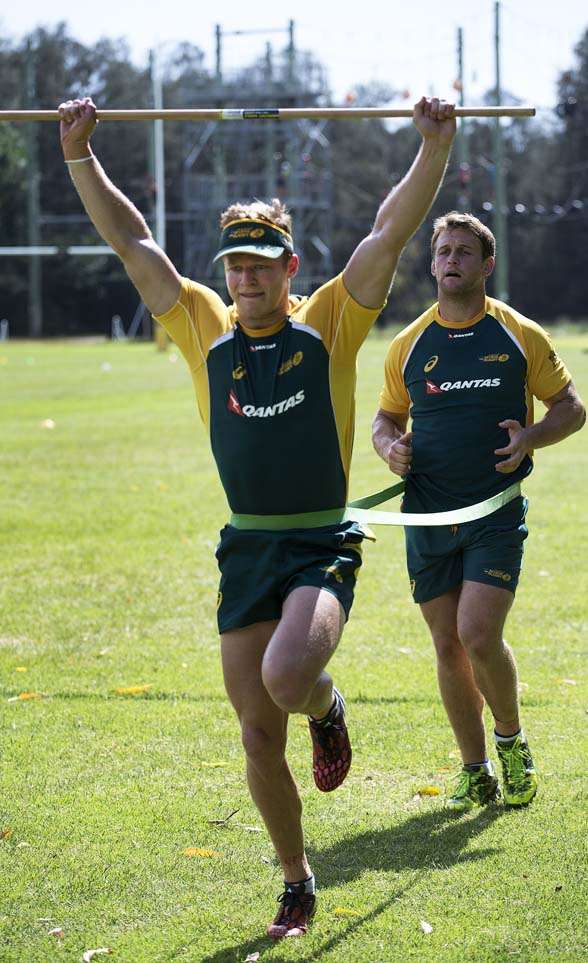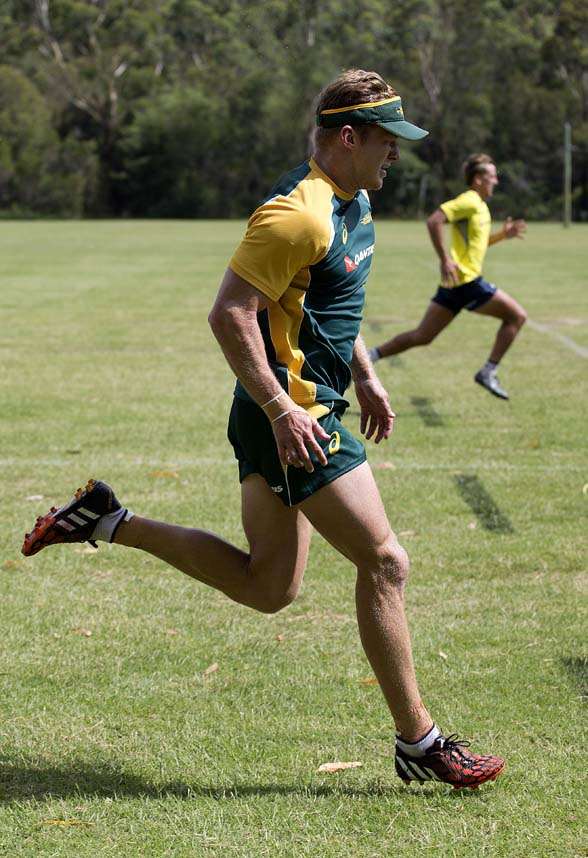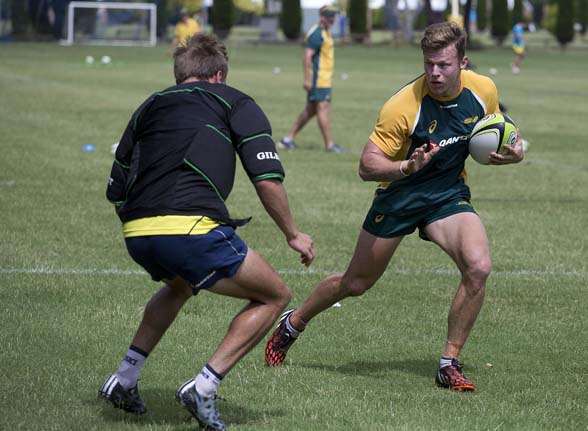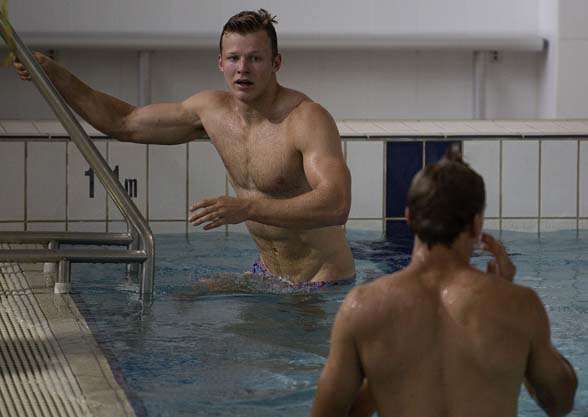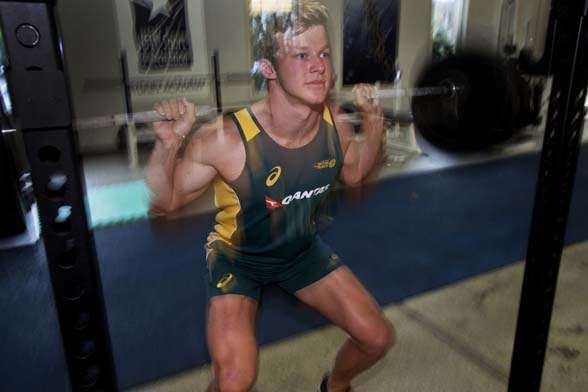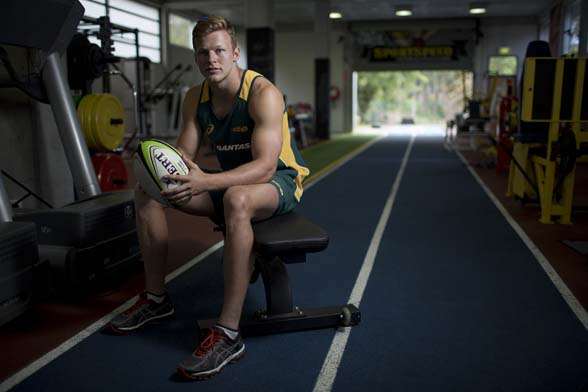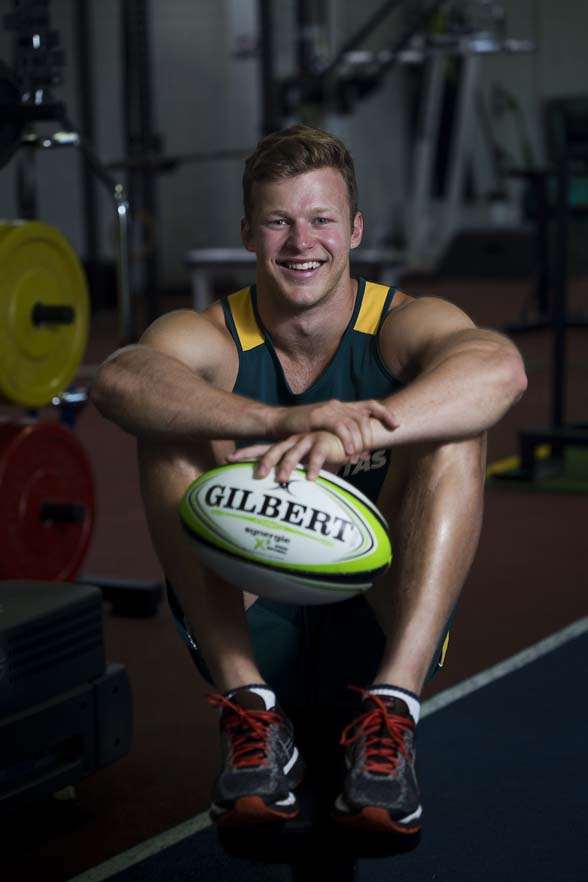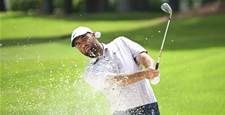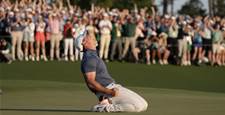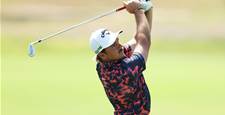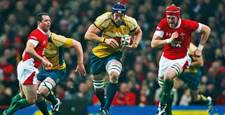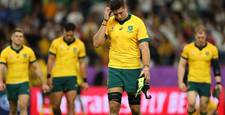At work with Australia's ultra-speedy and skilful centre.
“The Honey Badger” Nick Cummins, Aussie fly-half Quade Cooper and even Kiwi star Sonny Bill Williams are some of the 15-man-game stars to have been lured across to sevens ahead of this year’s Rio Games, but one of the tried and true sensations of the Aussie 7s men’s team is their ultra-speedy and skilful centre Cameron Clark. If you’re a rugger fan and Cameron happens to look a tad familiar, it’s because you’ve likely seen his dad Greg commentating the odd game over the years. But Cameron is a sensation in his own right. The 185cm, 83kg juggernaut scored 32 tries across the 2014-15 World Sevens Series, finishing equal fourth on the try-scoring list and fifth in points scored (218). The 2011 Australian Schoolboy and 2014 Commonwealth Games team member capped off a remarkable 2013-14 Series when was named in the IRB Men’s Sevens Team of the Year.
A quick World Sevens Series lesson for new students of the format: it’s 16 teams playing in ten tournaments, held in some of the most stunning cities on Earth. The thrilling Fijians are the defending series champs. The Aussie men currently sit about mid-table in the 2015-16 version.
Inside Sport has always been curious about how a sevens rugby side trains, so we quizzed and followed Clark around for a day at the Sydney Academy of Sport and Recreation on Sydney’s northern beaches, which doubles as home base for Australia’s Olympic-bound men’s and women’s squads. It was a filthy, humid, stinking hot day for our visit. We were left exhausted just watching. The lengths we go to for our readers ...
PLAYING THE PART
“I usually play centre. In sevens you have two props, a hooker, a halfback, 10, centre and wing. A good chunk of my role is around the mid-field; a lot of organising in defence, set pieces, just helping out the halves with moves. When you’re out a bit wider, it’s a lot easier to see what defences are doing, as opposed to those players who are always right in the thick of it. Communicating is another big part of the game when there’s only seven people on the field.”
TEAM MEETING
“Usually we’ll have two team meetings each week. Mostly these meetings are a review of our own training. We’ll review Monday’s and Wednesday’s training sessions on a Friday, and on the Monday we’ll review Friday’s session. Leading into tournaments, we’ll use that Friday meeting to analyse opposition teams as well. Today, for example, we had a look at Kenya [in Australia’s pool for the recently held Wellington 7s] and earlier in the week we analysed Portugal and Canada, the other two teams in our pool.
“The squad will break into groups for this analysis. Some people will look at attack, others at defence. It might be a set piece we’re focussing on; ‘restarts’ are a big team meeting subject, too; a very important part of sevens. Our meetings usually run for half an hour. Some days they’re over quickly. I guess today we had a lot to go through, so it went a little bit longer. As well as our coach Andy Friend and the players, our team manager Luca Liussi also sits in on these meetings; often he might have something constructive to say; housekeeping – getting passports in for travel, things like that.”
BEND AND STRETCH
“Before each field work session, we’ll prep to train. Here, we’ll go through a range of warm-up exercises, so that when we hit the training paddock we’re ready to go. Especially now with heavy training loads, guys are quite stiff and sore when they arrive here in the morning, so it’s a good opportunity to roll out any niggles or trigger areas that need work. There’s a generic component of this prep where everyone’s doing the same thing; on the rollers and different trigger [massage] balls and mobilisation exercises. Then at the end everyone breaks off and does specific movements catered just for them; they might have shoulder exercises they need to do, for example. Using the rollers and balls gets the body moving, as opposed to taking five-ten minutes to get going out on the field until you feel good. It’s all about injury prevention as well; making sure guys have all the right muscles firing and ready.”
DIET
“I wouldn’t say we have a set diet as a team, but a lot of the time we will have lunch on-site as a group. It’s catered, which is great. What’s on offer can change quite a lot, but there’s usually a hit of protein, a hit of carbs, veggies, salads. There’s breads and wraps available as well.
“There’s a big emphasis on snacking around our regimen, especially for our current period of training, where we’re having a few sessions each day. It’s about making sure you’re getting something in before and straight after a training session. Beforehand I’ll usually have some fruit – half an hour or an hour ahead of training; a banana or something. Between breakfast and our first training session can be quite a long wait if you have to sit through meetings, so we’re encouraged to eat during that period. After training they have protein shakes available. I’ll bring boiled eggs in just to snack on, or a handful of nuts, too.
“As far as supplements are concerned, often I’ll use some creatine. Sevens is all about repeat efforts and creatine helps with your ability to back up after each effort. It’s just a powder; you put a teaspoon in with your water. Also, a lot of the time we’ll use immune tablets and multi-vitamins to protect us during our travels; it can be quite easy to pick up bugs while flying and resetting your body clock and changing time zones. Probiotics are handy for that as well. Especially on hot days like today, there’s usually a mixture of Gatorade at the ready. They encourage us to get that on board, especially during the longer sessions.”
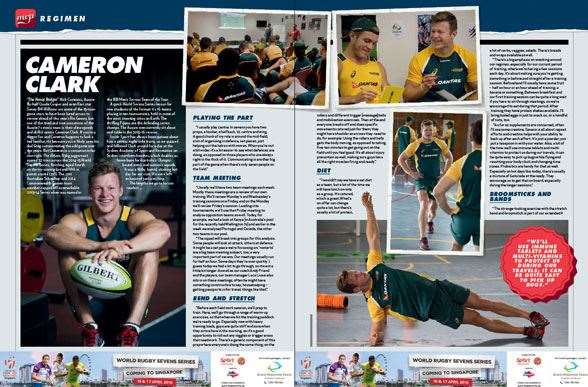 Inside Sport, March 2016 edition.
Inside Sport, March 2016 edition.BROOMSTICKS AND BANDS
“The strange-looking exercise with the stretch band and broomstick is part of our extended warm-up. It’s a bit of speed technique-stuff. The broomsticks are used in a way that ... rugby’s a bit different in that you’re not always sprinting in a straight line; often you’re having to have your hands up catching balls at full speed, rotating ... There’s a big focus here on hip position and feet position, being able to keep that firing while you’re being put in different positions, such as when you’re going for the ball. This is a good warm-up exercise to do before we really start sprinting.”
PADDING UP
“There’s a training station – with the green pads – which focusses on our ball presentation; taking the ball into contact and being able to present the ball back well. It’s a big focus of ours to give our halfback clean ball. If you can get quick ruck ball, it can be very effective. That’s been an area we’ve really been working on. Another exercise in this circuit involves running into two pads. This is more a contested breakdown-type movement. Our focus is to get really long and far away from defenders. If you get tackled from behind and there’s a defender in front of you, you can press the ball down, pick it back up and keep going. The third exercise on this circuit is one where we roll the ball between our legs and try to get up and make our own clean-out. It’s all purely ball presentation, that little circuit.”
FIJI TOUCH
“During each field session we play an open, continuous, adlib-type of game which we call ‘Fiji Touch’. Each player only gets one touch with the ball and if your team gets touched with the ball, it’s a turnover. It’s all about working off the ball but getting into a position where you can still get to it. In a turnover situation, it’s all about reacting with your team and connecting in a line and making sure your defence isn’t broken. Because Fiji Touch is continuous play, it’s also like a conditioning game; you certainly get a lot of metres in the legs; it gets you blowing.”
REHEARSAL TIME
“Especially now, with tournaments very close to each other, our training is getting progre-ssively more team-based; rehearsed plays off line-outs, tap moves off penalties, off scrums as well. The coaches like to bring in some decent contact, too. Not every phase in our field sessions is full-contact; it might be just every second phase; contesting at the ruck, for example. We have a few options off each of our set moves. Which options we choose can depend upon or change with each team you’re playing against. For example, every team defends a bit differently; what might work against one opposition might not work for another.
“We’ll play a few phases on the run and then we might come together for a chat in the middle of the field. People will bring up points about what needs to be fixed, or the coach will bring up certain things. Personally, I’ll be given feedback on the run from team-mates as well as the coaches.”
IN THE GYM
“We usually have a big leg session on Monday, an upper-body session on Tuesday, a speed/power-focus session on Thursday, while Friday is usually footwork; a bit lighter – more power-focussed as well. On Fridays there’s a bit of band-resistance stuff like stepping, a lot of hip-positioning. A bit of hurdle work with med balls, that sort of thing. Our main lifts are definitely Monday and Tuesday; Thursday and Friday are for topping up little specific things. Everyone in the gym gees each other up; it’s usually a bit of fun.”
DON’T THINK ABOUT RIO …
“We’ve qualified, but they definitely haven’t picked the squad or anything yet. We know we have a lot of improving to do; we didn’t get off to the start we wanted to for the season. We’ll be looking at making sure we’re in with a genuine gold-medal shot when it comes to Rio, but I don’t think many of us are looking that far ahead yet. There’s still a lot of work to be done before then.”
Related Articles

How to train like Aussie sevens star Cameron Clark

'Worlds best rugby sevens' could play NRLW
